The minimum number of gauges on a passenger car dashboard are the speedometer and the fuel gauge. The most common additional gauge is the temperature gauge followed by the tachometer, voltmeter and oil pressure gauge. If your car does not have a temperature gauge, oil pressure gauge or charging system gauge, then you will have a warning light for these functions.
The most common configurations in today’s cars are speedometer, tachometer, fuel, and temperature.

Speedometer
In the past, the most used of the gauges. The speedometer was usually driven by a cable that spins inside a flexible tube. The cable is connected on one side to the speedometer, and on the other side to the speedometer gear inside the transmission. Today, just about all vehicles have eliminated the cable and use an electronic sensor to measure wheel speed and send the signal to an electronically driven speedometer.
The accuracy of the speedometer can be affected by the size of the tires. If the tires are larger in diameter than original equipment, the speedometer will read that you are going slower then you actually are. On older vehicles, another cause for inaccurate speed readings was an improper speedometer gear inside the transmission. This can sometimes happen after a replacement transmission has been installed. Most good transmission shops are aware of this and will make sure that the correct speedometer gear is in the new transmission.

On vehicles with electronic speedometers, the computer has settings for speedometer calibration when necessary, to allow a technician to adjust for different sized tires. These calibrations usually require specialized equipment like diagnostic scanners to do these types of adjustments.
Fuel Gauge

Deliberately designed to be inaccurate! After you fill-up the tank, the gauge will stay on full for a long time, then slowly drop until it reads 3/4 full. After that, it moves progressively faster until the last quarter of a tank seems to go very quickly. This is a bit of psychological sleight-of-hand to give the impression that the car gets better gas mileage then it does, it seems to reduce the number of complaints from new car buyers during the first few weeks after they bought the car.
The fuel gauge shown here is probably more accurate than most. Notice the difference between 3/4 to full and empty to 1/4.
When the needle drops below E, there are usually 1 or 2 gallons left in reserve. To find out for sure, pull out your owner’s manual and find out how many gallons of gas your tank holds, then the next time you fill up an empty tank, check how many gallons it took to fill it. The difference is your reserve.
Note: It is not a good idea to let your tank drop below 1/4. This is because your fuel pump is submerged in fuel at the bottom of the tank. The liquid fuel helps to keep the fuel pump cool. If the fuel level goes too low and uncovers the pump, the pump will run hotter than normal. If you do this often enough, it can shorten the life of the fuel pump and eventually cause it to fail.
Temperature Gauge or Warning Lamp

This gauge measures the temperature of the engine coolant in degrees. When you first start the car, the gauge will read cold. If you turn the heater on when the engine is cold, it will blow cold air. When the gauge starts moving away from cold, you can then turn the heater on and get warm air.
Most temperature gauges do not show degrees like the one pictured here. Instead, they will read cold, hot, and have a normal range as pictured in the dash panel at the top of this page.
It is very important to monitor the temperature gauge to be sure that your engine is not overheating. If you notice that the gauge is reading much hotter than it usually is and the outside temperature is not unusually hot, have the cooling system checked as soon as possible.
Note: If the temperature gauge moves all the way to hot, or if the temperature warning light comes on, the engine is overheating! Safely pull off the road and turn the engine off and let it cool. An overheating engine can quickly cause serious engine damage!
Tachometer
The tachometer measures how fast the engine is turning in RPM (Revolutions Per Minute). This information is useful if your car has a standard shift transmission and you want to shift at the optimum RPM for best fuel economy or best acceleration. One of the least used gauges on a car with an automatic transmission. You should never race your engine so fast that the tach moves into the red zone as this can cause engine damage. Some engines are protected by the engine computer from going into the red zone. Usually, the tachometer shows single-digit markings like 1, 2, 3, etc. Somewhere, you will also see an indicator that says RPM x 1000. This means that you multiply the reading by 1000 to get the actual RPM, so if the needle is pointing to 2, the engine is running at 2000 RPM.
Oil Pressure Gauge or Warning Lamp
Measures engine oil pressure in pounds per square inch. Oil pressure is just as important to an engine as blood pressure is to a person. If you run an engine with no oil pressure even for less then a minute, you can easily destroy it. Most cars have an oil lamp that lights when oil pressure is dangerously low. If it comes on while you’re driving, stop the vehicle as soon as it is safely possible and shut off the engine. Then, check the oil level and add oil as necessary.
Charging System Gauge or Warning Lamp
The charging system is what provides the electrical current for your vehicle. Without a charging system, your battery will soon be depleted and your vehicle will shut down. The charging system gauge or warning lamp monitors the health of this system so that you have a warning of a problem before you get stuck.
When a charging problem is indicated, you can still drive a short distance to find help unlike an oil pressure or coolant temperature problem which can cause serious engine damage if you continue to drive. The worst that can happen is that you get stuck in a bad location.
A charging system warning lamp is a poor indicator of problems in that there are many charging problems that it will not recognize. If it does light while you are driving, it usually means the charging system is not working at all. The most common cause is a broken alternator belt.
There are two types of gauges used to monitor charging systems: a voltmeter which measures system voltage and an ammeter which measures amperage going out of, or coming into the battery. Most modern cars that have gauges use a voltmeter because it is a much better indicator of charging system health. A voltmeter is usually the first tool a technician uses when checking out a charging system.

A modern automobile has a 12-volt electrical system. A fully charged battery will read about 12.5 volts when the engine is not running. When the engine is running, the charging system takes over so that the voltmeter will read 14 to 14.5 volts and should stay there unless there is a heavy load on the electrical system such as wipers, lights, heater, and rear defogger all operating together while the engine is idling at which time the voltage may drop. If the voltage drops below 12.5, it means that the battery is providing some of the current. You may notice that your dash lights dim at this point. If this happens for an extended period, the battery will run down and may not have enough of a charge to start the car after shutting it off. This should never happen with a healthy charging system because as soon as you step on the gas, the charging system will recharge the battery. If the voltage is constantly below 14 volts, you should have the system checked. If the voltage ever goes above 15 volts, there is a problem with the voltage regulator. Have the system checked as soon as possible as this “overcharging” condition can cause damage to your electrical system.

If you think of electricity as water, voltage is like water pressure, whereas amperage is like the volume of water. If you increase pressure, then more water will flow through a given size pipe, but if you increase the size of the pipe, more water will flow at a lower pressure. An ammeter will read from a negative amperage when the battery is providing most of the current thereby depleting itself, to a positive amperage if most of the current is coming from the charging system. If the battery is fully charged and there is minimal electrical demand, then the ammeter should read close to zero, but should always be on the positive side of zero. It is normal for the ammeter to read a high positive amperage in order to recharge the battery after starting, but it should taper off in a few minutes. If it continues to read more than 10 or 20 amps even though the lights, wipers, and other electrical devices are turned off, you may have a weak battery and should have it checked.
Products Mentioned in this Guide
Any information provided on this Website is for informational purposes only and is not intended to replace consultation with a professional mechanic. The accuracy and timeliness of the information may change from the time of publication.


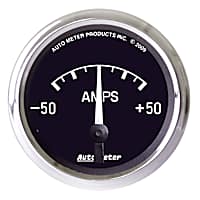 Ammeter
Ammeter
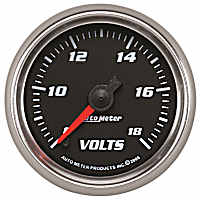 Voltmeter
Voltmeter
 Speedometer
Speedometer
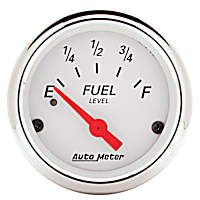 Fuel Gauge
Fuel Gauge
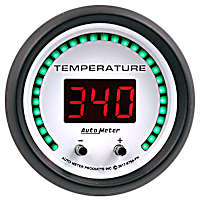 Temperature Gauge
Temperature Gauge
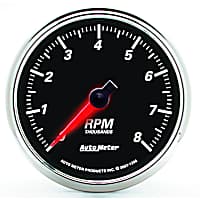 Tachometer
Tachometer














